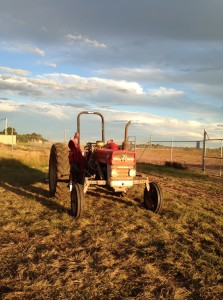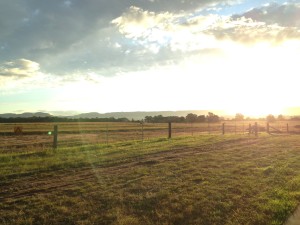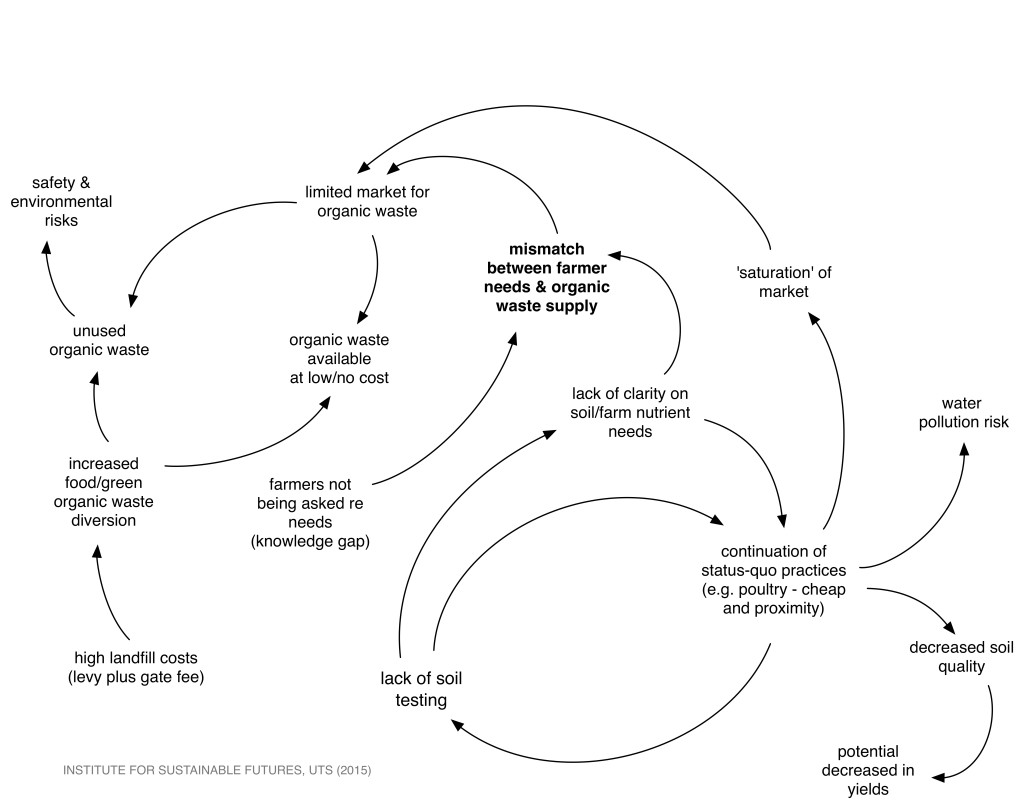WORKSHOP SYNTHESIS
Richmond, Sydney, 23rd June 2015

Organisers: Institute for Sustainable Futures, University of Technology Sydney
Co-hosts: ACE Ohlsson & Local Land Services (NSW Government)
New pressures and opportunities are facing the Sydney Basin in relation to waste and nutrient management. While landfill gate fees are rising (already $300/tonne), future phosphate fertiliser availability and price are uncertain due to increasing global scarcity and geopolitical risks, making further price spikes likely. Accommodating 1.5 million new Sydney residents expected over the next 20 years coupled with a lack of planning policies to protect or prioritise agriculture means fertile land is being paved over. As such land prices are rising and farmers are selling up or being pushed out. Urban growth is also creating the need for new water and wastewater infrastructure. The Sydney Basin is generating an excess of phosphorus and organic matter that could be used as ‘renewable fertilisers’, and a need for new infrastructure creates an opportunity to design-in cost-efficient nutrient recovery systems upfront to avoid expensive retrofits.
 This workshop brought together agronomists, farmers, waste managers and fertiliser/nutrient service providers to better understand the risks and opportunities around recycling organic material – particularly phosphorus – in the Greater Sydney Basin. Specifically, workshop objectives were to:
This workshop brought together agronomists, farmers, waste managers and fertiliser/nutrient service providers to better understand the risks and opportunities around recycling organic material – particularly phosphorus – in the Greater Sydney Basin. Specifically, workshop objectives were to:
- better understand growers needs, priorities, and preferences regarding the use of organic-based fertilisers
- identify barriers and opportunities for new markets in recycled phosphorus
- identify actions required to improve the sustainable use of nutrients in the Sydney Basin
The workshop first showcased the latest research undertaken by the Institute for Sustainable Futures (ISF) of the University of Technology Sydney on global risks on the horizon associated with phosphorus fertiliser scarcity and pollution and implications for Australia and Sydney. This was followed by a presentation of recent research that has spatially mapped hotspots of phosphorus supply and demand in the Basin. The latter was funded by an Australia Government Endeavour Research Fellowship and in-kind contributions from ISF. An overview of the state of phosphorus management in Sydney soils was provided from the perspective of a local agricultural service provider, ACE Ohlsson, followed by an overview of the state of organic waste management, by Resource Recovery Australia. The workshop was physically hosted by NSW Local Land Services at the Richmond field demonstration site.
The views expressed in this synthesis are those of the workshop participants. The workshop was not intended to represent all farmers/sectors in the Sydney Basin[1], but rather to initiate a conversation with stakeholders taking a lead in this area, and to pilot a process for bringing together different sectors in future discussions.
CURRENT SITUATION
Workshop participants noted that there is a current mismatch of nutrients and organic matter in the Sydney Basin: much of the State’s soils lack organic matter – while most of Sydney’s municipal waste is in fact organic. However in nutrient terms, the supply of potential nutrients from urban wastes (food & green waste, wastewater/biosolids and animal manure[2]) is fifteen times higher than crop demand in the Basin.
Sydney’s agricultural soils are generally saturated in phosphorus – concentrations can reach 900ppm, and average 300ppm. This can be attributed partly to low soil testing rates (excluding dairy) in the Sydney Basin, compared to the higher rate of testing in sensitive inland catchments, broadacre farms (and other parts of the developed world such as in the USA or European Union). Agronomist participants noted that among their customers soil testing was in the range of 5% for graziers and 30-40% for vegetable growers. Some famers perceived the costs associated with testing to be too high (although in reality this could be $140, compared to thousands of dollars spent on fertiliser inputs, hence the gains could be significant). Participants also noted that regardless of fertiliser type (organic or chemical), fertiliser application timing is not always considered.
Despite the current mismatch between organic waste generated in the Basin and demand, there is still widespread use of organic fertilisers in the Basin. Participants noted that poultry manure (pasturised for safety) was most commonly used. The agronomists suggested usage rates among their customers were in the order of 90% in horticulture (including Asian vegetables), 40-50% in viticulture, and 40% in pasture systems. Other organic wastes were also being used, although more likely for non-agricultural purposes or outside of the Basin. For example, most urban green waste continues to be used for urban amenity (i.e. open green space), while most biosolids are trucked over the mountains for use in broadacre agriculture.
The quality of organic wastes destined for reuse varies, in part due to the highly variable rate of household contamination of organic waste by local government area (e.g. 0.4% Queanbeyan compared with 10% Penrith).
BARRIERS TO CHANGE
Participants identified and discussed a range of barriers that might be preventing more efficient use of organics in the Sydney Basin. These ranged from product characteristics and lack of soil testing through to regulatory and institutional fragmentation and differing stakeholder perspectives (see figure).
Product attributes were emphasised as an obstacle. For example, some organic wastes are viewed as a ‘black box’ as farmers and agronomists don’t know the composition of the products, in part because they vary from batch to batch. This also makes it difficult for resource managers and fertiliser companies to market a product with such variable qualities and characteristics. It is unclear whether standardised products on the market would be best, or if it would be more appropriate to provide a tailored product coupled with agronomic advice to meet local farmer needs.
Lack of soil testing coupled with limited knowledge and awareness of the diverse range of potential products (from struvite to green waste) and their specific characteristics might limit the ability of nutrient managers to advise or sell such products (e.g. the difference between poultry manure and compost, and when it might be appropriate to use these). Further, despite farmers being the primary end user or market for organic wastes, there has been little research regarding ‘what farmers want’ in an organic fertiliser/amendment product within the Basin.
Figure: participant perspectives on factors creating barriers to change in the Sydney Basin.
At the institutional cross-sector scale there is a persistent disconnect, which needs to be overcome. First, different stakeholders can perceive the problem and opportunities of organic waste quite differently from each other, depending on their sector perspective. For example, while waste managers see organic collection and reuse as a waste issue and are more focused on diverting organic waste from landfill, agronomists might see it as a soil amendment issue (rather than the fertiliser value of organics), while farmers are focused more on the economic benefits. Urban residents still tend not to see the direct effect of their actions on agriculture. For example, urban residents may not see the implications for the organics market of separating at source their domestic organics to minimise contamination and thus capacity to grow food with such soil amendments, or the impact of their food retail choices (e.g. shopping at a major supermarket or local markets) on farmer livelihoods. Consumers have been somewhat conditioned to demand flawless and clean fruits and vegetables, which can limit the type of inputs that farmers are willing to use if there is a perceived risk that it could compromise appearance, safety or productivity, and hence marketability and profitability. Participants also stressed that the major supermarkets still dictate farmers’ terms of trade, and hence need to be involved in solutions.
Current market and regulatory signals may also be hindering change. For example, while high landfill costs (levy plus gate fee) encourage organic waste diversion, they do not stimulate productive reuse for food production (or waste avoidance). This regulatory situation also doesn’t systematically encourage quality products (e.g. low/no-contamination). Participants perceived a saturation in the organics market with poultry manure with which high-quality compost cannot compete (e.g. poultry manure can be bought for $12-14/m3, while compost can cost $28/m3 or more if transported outside the Basin).
ENABLERS OF CHANGE
Participants discussed what existing attributes or resources might enable change towards more efficient and integrated reuse of nutrients and organics in the Sydney Basin. This discussion largely focused on physical attributes. For example, for those already using a bulky product like chicken manure, a switch to compost could be straight forward in terms of spreading equipment, as these would likely be the same. Similarly, for those using chemical fertilisers, the switch to struvite would be simple in terms of handling and physical application.
Participants also identified some of the desirable characteristics of a fertiliser product, regardless of source:
- known nutrient and contaminant levels
- known nutrient release (site specific)
- standardised
- no weed seeds
- no pathogens
- no plastic
- no heavy metals
- easy to use
- no odour
- pasturised (if organic matter) to avoid biosecurity risks
Other enabling attributes identified included new policies and momentum for change, such as the EPA Waste Less Recycle More grants, or opportunities to expand the national Product Stewardship Act to include organics.
WHERE TO FROM HERE
 Participants were asked to identify next steps to transition to a more sustainable and viable situation. The discussion centered on increasing knowledge, awareness and deliberation between and across all key stakeholder groups, as this was seen as a key gap or priority.
Participants were asked to identify next steps to transition to a more sustainable and viable situation. The discussion centered on increasing knowledge, awareness and deliberation between and across all key stakeholder groups, as this was seen as a key gap or priority.
For example, the provision of education/extension for both agronomists and farmers to better understand the processing, handling and application of a range of organic materials/fertilisers. Such training could occur via demonstration sites and on-farm composting, however further funding would be required to maintain or increase such outreach programs. Householders could be further motivated to source-separate through improved messaging, such as organic ‘waste’ is used to grow your food, therefore don’t put glass in your compost bin.
Suggestions were also made on the policy side. For example, pre-fertiliser application soil testing could be made mandatory, in line with other parts of the developed world. Levies or fines could explicitly deter householders from putting organics in general waste bins, or incentives to stimulate non-contaminated source separation. However the need to balance local and state government responsibilities was raised. Overcoming the disconnection between industry and regulators could be achieved via deliberative processes to harmonize policies, practices, and incentives towards a shared desired outcome regarding the productive and profitable reuse of organics. For example, EPA could assist productive re-use by expanding the suite of instruments used rather than relying on only risk minimization through regulations (e.g. to level the playing field, organics for reuse could be considered on-par with other commercial fertilisers which aren’t as heavily regulated in such a risk-averse manner with respect to application and use).
Systems level knowledge across sectors within the Sydney Basin was also identified as a strong need, to optimize and share the costs and benefits of organics recycling, in addition to coordinating and harmonizing policies and practices. For example, undertaking a study of who pays and who benefits in the current waste management system in order to better value the waste stream (e.g. a study to “follow the money” then investigate how costs could be distributed could help to maximize desired outcomes of waste reuse). Identifying the costs and benefits to the whole-of-society and within each sector (e.g. avoided costs for farmers using organic fertiliser products associated with reduced water use, reduced pesticide input costs associated of improved soil quality) could help many sectors in meeting existing goals, as well as providing a realistic comparison of costs between a tonne of ‘renewable fertiliser’ and the current market price of a tonne of mined phosphorus.
For more information, please contact Dr Dana Cordell (Dana.Cordell@uts.edu.au) or Dr Genevieve Metson (genemetson@gmail.com) at the Institute for Sustainable Futures, University of Technology Sydney.
FURTHER RESOURCES
Mapping Sydney’s phosphorus supply and demand
http://www.p-futurescities.net/sydney-australia/#MappingSydney
Global phosphorus scarcity and pollution
(PDF of presentation coming soon)
P-FUTURES: Sydney
http://www.p-futurescities.net/sydney-australia/
ACE Ohlsson
http://www.aceohlsson.com.au/
Resource Recovery Australia
http://resourcerecovery.org.au/
Australian Sustainable Phosphorus Futures
http://phosphorusfutures.net/australian-sustainable-phosphorus-futures.html
Sydney’s Food Futures
(weblink coming soon)
[1] Agronomists specialised in horticulture, viticulture and pasture-based systems, however were all from ACE Ohlsson. Farmer representation in this workshop was minimal due to constraints on time/availability.
[2] Including poultry, cattle, sheep and pig manures, but excluding pasture-based animal systems where manures typically stay onsite.

